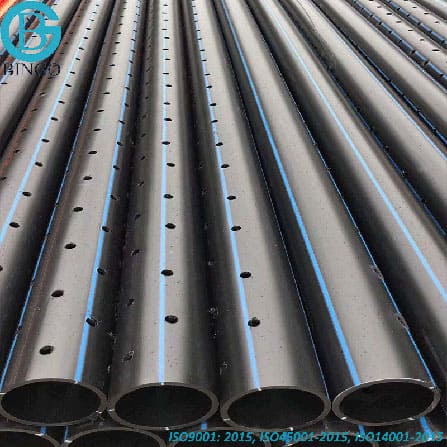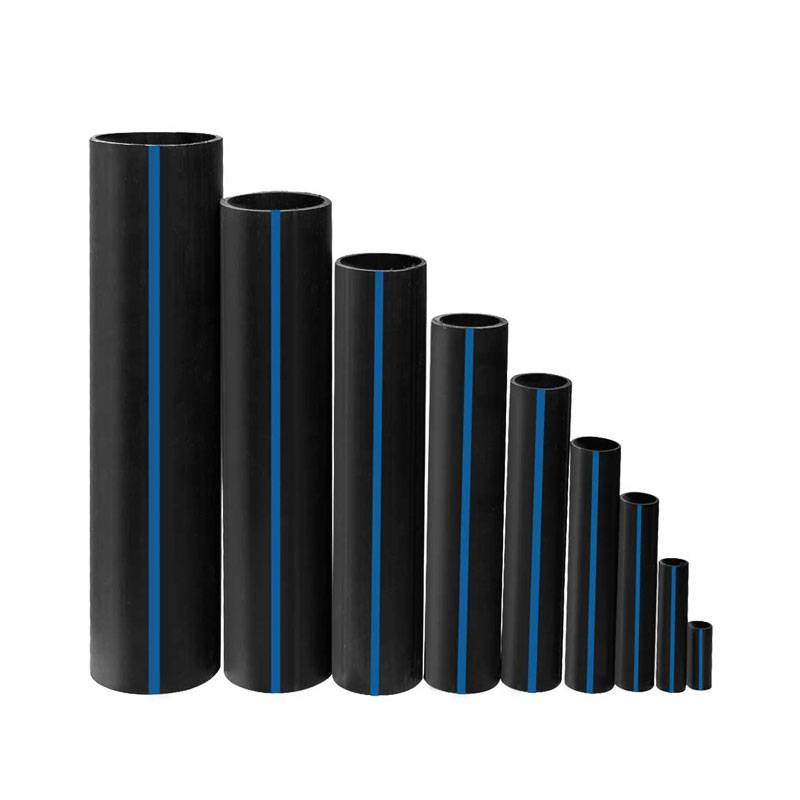Texas hdpe pipe manufacturer: Green Manufacturing
Wiki Article
Explore the Production Refine Behind High-Quality HDPE Pipeline and Its Applications
The production process of high-quality HDPE pipelines is detailed and methodical. It starts with the choice of raw materials that improve efficiency. Following this, ethylene goes through polymerization to develop resin, which is then shaped via extrusion. Quality control is vital, making sure that the last item meets stringent criteria. Nevertheless, the journey of HDPE pipelines doesn't finish with manufacturing. Their applications throughout various markets expose a wider significance worth examining.Recognizing HDPE: Qualities and Advantages

High-density polyethylene (HDPE) is a flexible thermoplastic recognized for its resilience and resistance to various ecological elements. This product exhibits superb tensile toughness, making it suitable for requiring applications. Its low-density structure adds to a light-weight item, helping with ease of handling and installation. HDPE likewise showcases exceptional resistance to chemicals, which decreases deterioration when exposed to extreme substances.
The product's low wetness absorption better improves its durability, making it ideal for use in pipes and tank. Furthermore, HDPE is immune to ultraviolet (UV) radiation, ensuring that products keep their integrity also when revealed to sunshine. Furthermore, its adaptability enables the development of complex shapes without compromising stamina. The environment-friendly nature of HDPE, typically originated from recycled materials, contributes to its appeal, promoting lasting practices in manufacturing. In general, these buildings and advantages make HDPE a preferred choice for various industrial and consumer applications.
Raw Material Choice for HDPE Production
The selection of raw products for HDPE production is important to confirm the end product satisfies the preferred requirements and top quality requirements. High-density polyethylene (HDPE) is mostly created from polymerized ethylene, originated from nonrenewable fuel sources such as all-natural gas or unrefined oil. The top quality of these feedstocks greatly influences the mechanical and thermal buildings of the last HDPE.Additives also play a significant function in improving HDPE's performance, consisting of anti-oxidants, UV stabilizers, and colorants, which boost longevity and resistance to environmental variables. The selection process should think about not only the chemical structure of the raw materials but additionally their processing characteristics to ensure effective production.
The sourcing of raw materials should prioritize sustainability and conformity with environmental regulations, as responsible methods are necessary in today's market. Eventually, careful resources choice lays the structure for producing high-grade HDPE pipes ideal for diverse applications.
The Extrusion Process: Forming HDPE Pipeline
The extrusion process plays an important duty in shaping HDPE pipelines, beginning with precise material prep work techniques that guarantee perfect flow and uniformity. Similarly essential is the layout of the die, which directly affects the final dimensions and surface area high quality of the pipe. With each other, these aspects contribute considerably to the effectiveness and quality of HDPE pipe production.Material Preparation Strategies
Reliable manufacturing of HDPE pipes starts with meticulous material preparation strategies, specifically the extrusion procedure. Throughout this stage, high-density polyethylene material is initial dried to remove wetness, making certain excellent circulation features. The material is after that fed into the extruder, where it goes through home heating and melting, transforming into a thick state. This heating procedure is meticulously controlled to keep the product's integrity and performance. The liquified HDPE is required with a die, forming it right into a continual pipe form. visit site Proper temperature monitoring during extrusion is vital, as it directly impacts the material's properties and the end product quality. As soon as shaped, the HDPE pipe is cooled down and reduced to specified lengths, prepared for succeeding processing and applications.Die Layout Relevance
Precision in die style plays a crucial duty in the extrusion procedure of HDPE pipes. The die offers as the final shaping device, straight affecting the pipeline's measurements, wall density, and surface area finish. A well-designed die warranties uniform product flow, minimizing defects such as irregularities and weak points. The geometry of the die should be maximized to fit the certain residential properties of HDPE, including its thickness and thermal behavior during extrusion. In addition, the cooling rate of the material as it travels through the die can significantly impact the pipe's architectural integrity. Investing in sophisticated die modern technology is crucial for producers aiming to create premium HDPE pipes that satisfy industry criteria and consumer assumptions.Top Quality Control Actions in HDPE Manufacturing
Although different elements affect the quality of HDPE pipe production, efficient top quality control actions are vital to assure consistency and integrity in the final product. Key quality control practices include extensive material assessment, confirming that the raw polyethylene fulfills well established criteria for purity and density. Throughout the extrusion process, criteria such as temperature level, stress, and cooling time are carefully monitored to maintain dimensional accuracy and structural integrityIn addition, post-production screening is vital; producers typically conduct hydrostatic examinations to evaluate the pipe's toughness and resistance to stress. Aesthetic examinations for surface defects further enhance quality control. Accreditation from relevant requirements organizations, like ASTM or ISO, gives an added layer of reliability. By executing these complete quality assurance steps, producers can reduce issues, enhance efficiency, and ensure that the HDPE pipes meet the details requirements of numerous applications, ultimately bring about client contentment and count on the item.
Applications of HDPE Pipeline Across Industries
HDPE pipes are utilized throughout numerous fields due to their toughness and flexibility. In water distribution systems, they guarantee reliable delivery, while in wastewater administration, they supply trustworthy services for waste transport. In addition, farming watering networks take advantage of HDPE's resistance to rust and flexibility, making it a perfect choice for modern-day farming techniques.
Water Distribution Solutions
A substantial number of industries rely upon high-density polyethylene (HDPE) pipes for effective water distribution systems. Understood for their durability and resistance to rust, HDPE pipes are commonly used in community water system networks, farming irrigation, and industrial applications. Their light-weight nature helps with simple handling and installment, lowering labor costs and time. In addition, HDPE pipelines can suit different stress degrees, making them suitable for both low and high-pressure systems. custom hdpe pipe manufacturing Midland TX. The flexibility of the product enables for smooth integration right into existing infrastructure, reducing the requirement for considerable excavation. HDPE's resistance to chemical seeping warranties that the water provided remains safe and tidy, making it a perfect option for preserving the quality of safe and clean water across various industries.Wastewater Management Solutions
Reliable water circulation systems additionally lead the method for cutting-edge wastewater management solutions, where high-density polyethylene (HDPE) pipes play a substantial function. Prominent for their durability and resistance to corrosion, HDPE pipes are optimal for delivering wastewater in various settings. Their adaptability permits for easy installment in complex atmospheres, decreasing the demand for substantial excavation. Additionally, HDPE's sites smooth indoor surface area lowers rubbing, enhancing circulation rates and efficiency. These pipelines are likewise immune to chemical leaching, making certain that contaminants do not jeopardize the surrounding atmosphere. Industries, towns, and therapy centers increasingly depend on HDPE pipes for their integrity and longevity, making them a preferred option for modern wastewater administration systems. This versatility underscores the critical value of HDPE pipelines throughout numerous applications.Agricultural Watering Networks
Agricultural watering networks profit greatly from the usage of high-density polyethylene (HDPE) pipes, which give effective and dependable water distribution to crops. HDPE pipelines are lightweight, making them simple to move and mount, while their flexibility permits different arrangements in diverse terrains. These pipes show superb resistance to deterioration, chemicals, and UV radiation, making sure toughness in extreme farming atmospheres. Furthermore, their smooth interior surface area minimizes friction loss, enhancing water circulation and reducing power costs associated with pumping. The longevity of HDPE pipes, often surpassing 50 years, contributes to reduce maintenance and substitute costs. Farmers significantly depend on HDPE pipelines to enhance irrigation effectiveness and advertise sustainable farming practices, eventually leading to improved plant yields and source conservation.
Future Fads in HDPE Pipeline Modern Technology
As the need for sustainable and reliable facilities grows, innovations in HDPE pipe modern technology are positioned to transform numerous sectors. Emerging fads include the combination of clever technologies, such as sensors and IoT capacities, which promote real-time monitoring of pipe problems, lowering upkeep costs and stopping leaks. In addition, the development of innovative manufacturing methods, such as 3D printing, is enabling the manufacturing of facility, personalized pipeline layouts that deal with details job needs.The focus on recycling and circular economic climate practices is driving the advancement of HDPE pipes made from recycled products, boosting sustainability. Improved jointing methods, such as electro-fusion and mechanical installations, are additionally improving installment effectiveness and dependability. The growing emphasis on environmental policies is pressing suppliers to take on greener production processes, ensuring that HDPE pipes not just meet industry criteria but likewise foster a more sustainable future for infrastructure advancement.
Frequently Asked Inquiries
How Does HDPE Contrast to Other Plastic Materials?
HDPE exceeds several other plastic materials concerning longevity, chemical resistance, and adaptability. Its reduced density and high tensile strength make it perfect for various applications, frequently going beyond choices in both performance and longevity.What Are the Environmental Influences of HDPE Production?
The ecological more tips here influences of HDPE manufacturing include greenhouse gas exhausts, power usage, and prospective contamination from producing procedures. Furthermore, improper disposal can result in soil and water contamination, raising issues regarding long-lasting eco-friendly impacts.Can HDPE Pipes Be Reused?
Yes, HDPE pipelines can be recycled. Lots of centers approve made use of HDPE for handling, changing it into brand-new products. This reusing adds to sustainability efforts, decreasing plastic waste while conserving sources and power in the manufacturing cycle.What Is the Lifespan of HDPE Pipeline?

Just How Do Temperature Variations Influence HDPE Pipe Efficiency?
Temperature level variations significantly impact HDPE pipeline efficiency, affecting versatility and strength. High temperature levels can cause softening, while reduced temperatures might trigger brittleness, eventually affecting the pipeline's resilience and viability for numerous applications in varied environments.Report this wiki page